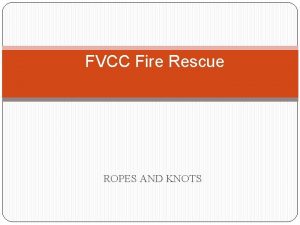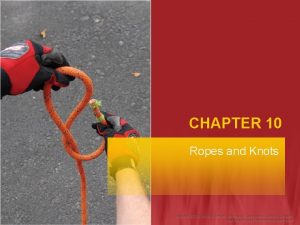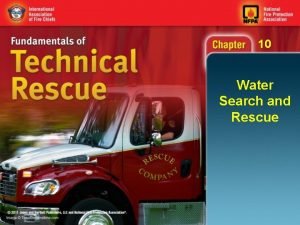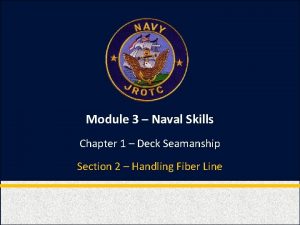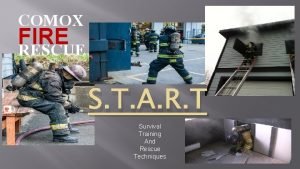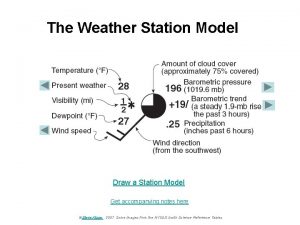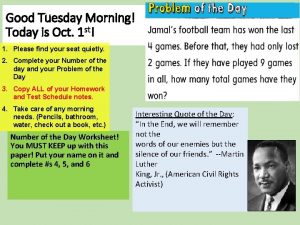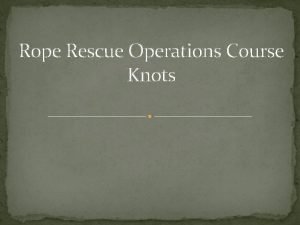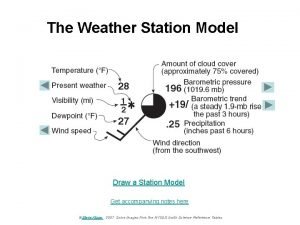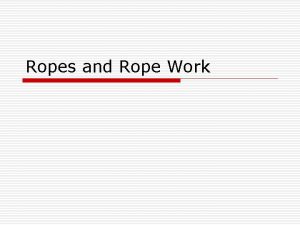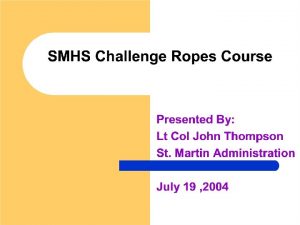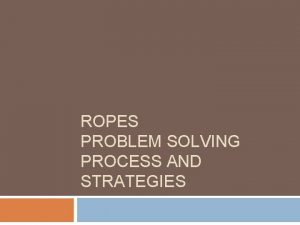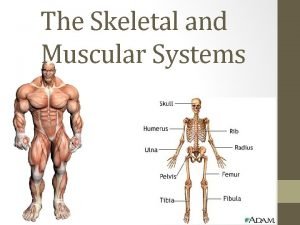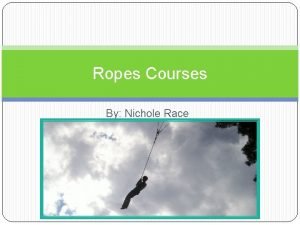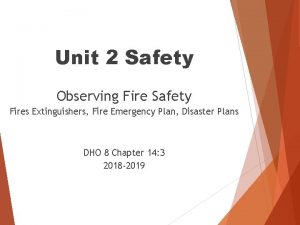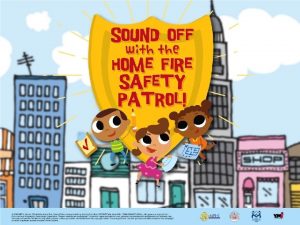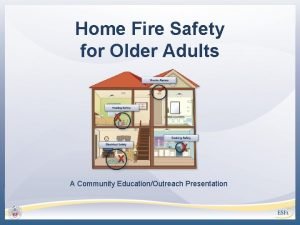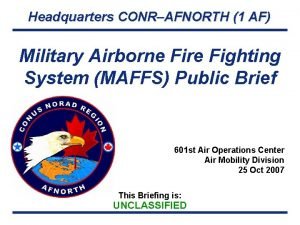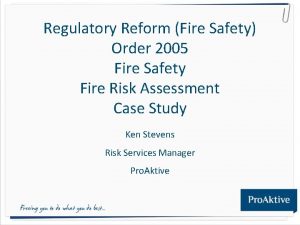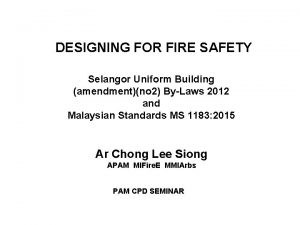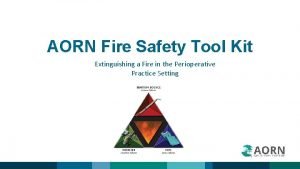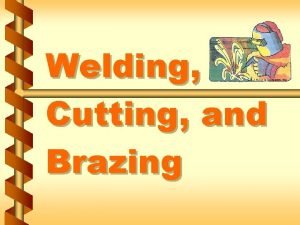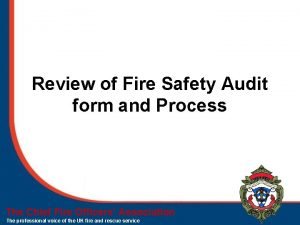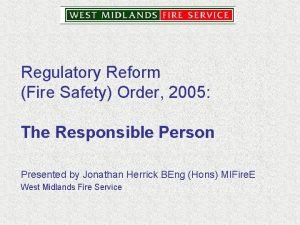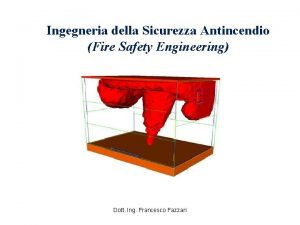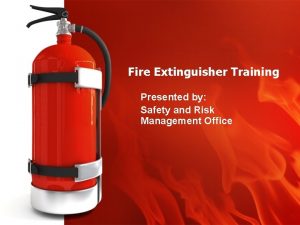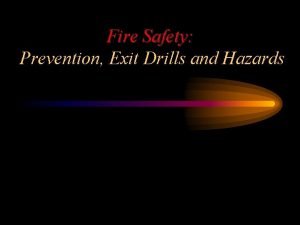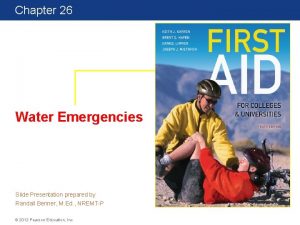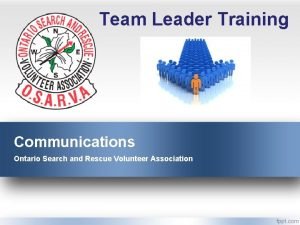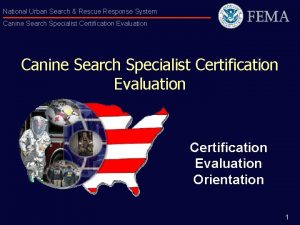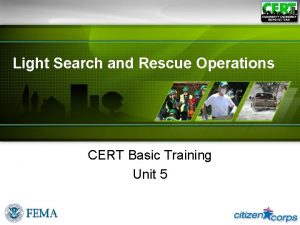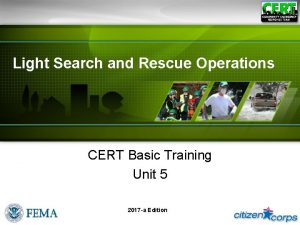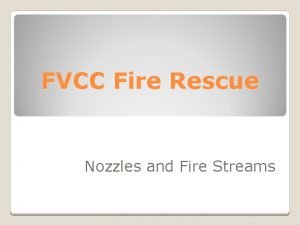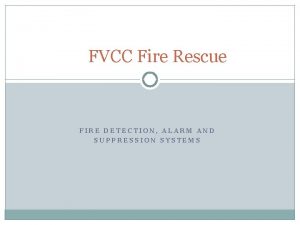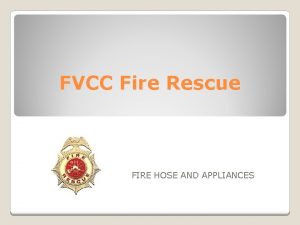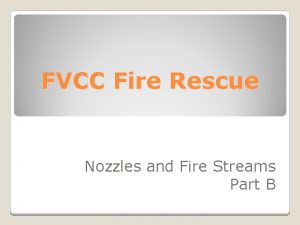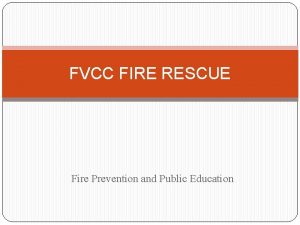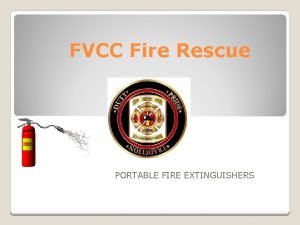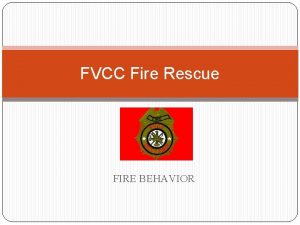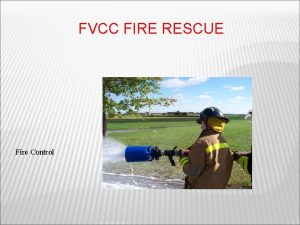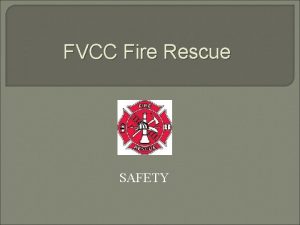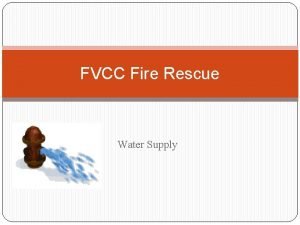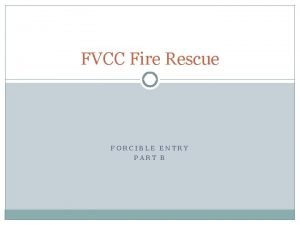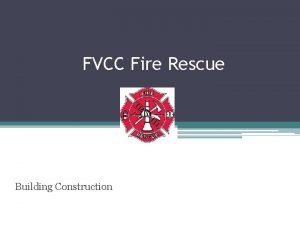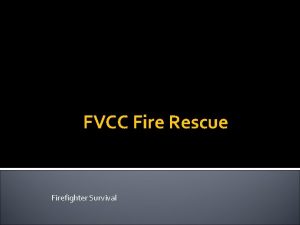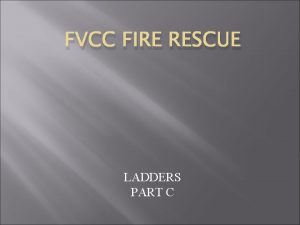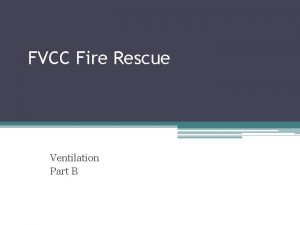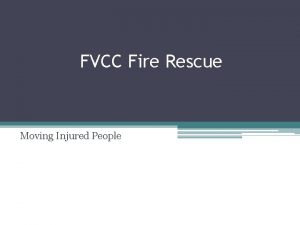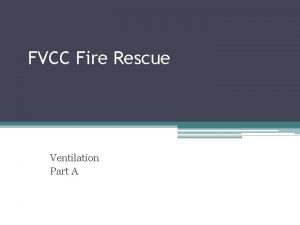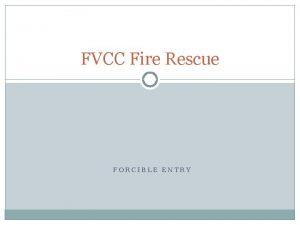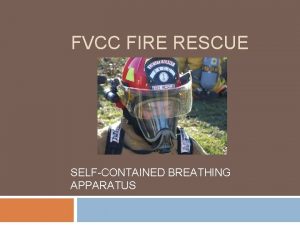FVCC Fire Rescue ROPES AND KNOTS LIFE SAFETY








































































- Slides: 72

FVCC Fire Rescue ROPES AND KNOTS

LIFE SAFETY & UTILITY ROPE APPLICATIONS Life Safety Used solely to support rescuers/victims Must be synthetic, block creel, virgin fiber May not be reused unless meets all reuse criteria Utility Used for any but life safety applications May be synthetic or natural fiber May be reused TS 6– 1

CRITERIA FOR REUSING LIFE SAFETY ROPE TS 6– 2 Has no visible damage Has never been exposed to heat, flame, or abrasion Has never been subjected to any impact load Has never been exposed to harmful chemical liquids, solids, gases, mists, or vapors Passes inspection before and after each use

Homework Distinguish between life safety and utility rope applications. Mark “A” for life safety applications or “B” for utility rope applications. 1. __ Pulling someone from the water 2. __ SCBA guide rope 3. __ Tag line 4. __ Securing backpack assembly to confined space rescuer's harness when rescuer cannot enter space wearing standard SCBA 5. __ Securing a victim in a Stokes basket 6. __ Cordoning off an area 7. __ Hanging a salvage cover to dry 8. __ Hoisting a tool or piece of equipment 9. __ Safety harness tie-in during confined space entry 10. __ Securing a charged hose to a ladder 11. __ Drying clothes 12. __ Lowering a victim from a building during training exercise 13. __ Rappelling 14. __ Roping off an area 15. __ Stabilizing a vehicle for extrication

VS 6 -1 ROPE TERMINOLOGY Strand Yarns Sheath or Jacket Mantle Fibers Core Kern

VS 6 -2 ROPE CONSTRUCTION Laid (Twisted) Braided Braid-on-Braid Static Kernmantle Dynamic Kernmantle

Homework Match rope materials to their descriptions. Write the correct letters on the blanks. 16. Strong, hard fiber from the abaca plant; type #1 best for rope and identified by a colored string twisted into the fibers; short, non-continuous strands provide poor tensile strength 17. Synthetic rope with three to three and one-half times the tensile strength of manila, but may lose up to 15 percent of its strength when wet; stretches under load so is not suitable for vehicle stabilization or similar applications 18. Synthetic fiber sometimes known as Dacron®; particularly suitable to high-strength, low-stretch applications such as vehicle stabilization; very susceptible to damage by alkalis 19. Very lightweight synthetic rope used for water rescue because it absorbs no water and floats; difficult fiber to secure into solid knots and hitches a. Manila b. Nylon c. Polyethylene d. Polyester

Homework Match rope materials to their descriptions. Write the correct letters on the blanks. 20. Same synthetic fiber as that used in bulletproof vests; also known as Kevlar®; easily damaged by abrasion so must be sheathed in polyester or nylon; very difficult to knot 21. Soft, pliable natural fiber; generally white or light colored; most susceptible to physical abrasion and damage of all natural fiber ropes 22. New synthetic fiber with a high molecular weight; strongest of the synthetic rope fibers; also known as H. Spectra® 23. Very lightweight fiber from same synthetic family as polypropylene; surface has slick, oily feel; can be manufactured in bright colors for good visibility a. b. c. d. Gel spun polyethylene Cotton Polypropylene Aramid

TS 6– 3 NATURAL FIBER ROPE Types Manila Sisal Cotton Used for many years Is no longer accepted for life safety applications

TS 6– 4 SYNTHETIC ROPE Types Nylon Polypropylene Polyester § Aramid § Gel spun polyethylene (H. Spectra®) Polyethylene Preferable to natural fiber rope Excellent resistance to mildew and rotting Excellent strength

TS 6– 5 DYNAMIC (HIGH STRETCH) ROPE Used when long falls are a possibility Designed for high stretch without breaking Not considered practical for hauling applications

TS 6– 6 STATIC (LOW STRETCH) ROPE Preferred for rescues requiring raising and lowering heavy loads Designed for low stretch without breaking Used for hauling, rescue, rappelling, and where no falls are likely to occur or only very short falls are possible

LAID (TWISTED) ROPE CONSTRUCTION TS 6– 7 Constructed by twisting yarns together to form strands; three strands twisted together make final rope Susceptible to abrasion and other types of physical damage

BRAIDED ROPE CONSTRUCTION TS 6– 8 Is constructed of uniformly intertwined strands Reduces or eliminates twisting common to laid ropes Is subject to direct abrasion and damage

TS 6– 9 BRAID-ON-BRAID (DOUBLE BRAID) ROPE CONSTRUCTION Is constructed with both a braided core and a braided sheath Is very strong Does not resist abrasion as well as kernmantle; sheath may slide along the inner core of the rope

KERNMANTLE ROPE CONSTRUCTION TS 6– 10 Has braided covering or sheath over main load-bearing strands Comes in both dynamic and static types

Homework Select facts about rope construction. Write the correct letters on the blanks. 23. What type of rope construction is illustrated above? a. Laid b. Braided c. Braid-on-braid d. Kernmantle 24. Firefighter A says that static rope stretches very little. Firefighter B says that dynamic lines stretch more than static lines under weight and shock loads. Who is right? a. Firefighter A b. Firefighter B c. Both A and B d. Neither A nor B 25. Why is static rope preferred for rescue work? a. Its elasticity absorbs the weight of a fall b. It has a low stretch factor c. It has a high stretch factor d. It stretches more than dynamic rope under weight and shock loads

Homework 26. What statement below is true in regard to laid (twisted) rope construction? a. The tightness of the lay (twist) determines the rope’s properties. b. Generally six strands are twisted together to make the final rope. c. Twisted rope is resistant to abrasion and other types of physical damage. d. Twisted rope is difficult to inspect. 27. What type of rope construction is illustrated below? a. Laid b. Braided c. Braid-on-braid d. Kernmantle 28. Firefighter A says that braided rope eliminates the twisting common to laid ropes. Firefighter B says that braided rope is constructed mostly of natural fibers though some are made from synthetic fibers. Who is right? a. Firefighter A b. Firefighter B c. Both A and B d. Neither A nor B

Homework 29. What type of rope construction is illustrated below? a. Laid b. Braided c. Braid-on-braid d. Kernmantle 30. How many strands are there generally in a laid rope? a. Seven b. Five c. Three d. Two 31. Which of the following ropes possesses half its strength in its sheath and the other half in its core? a. Laid b. Braided c. Braid-on-braid d. Kernmantle

Homework 32. Which type of rope construction is also called twisted construction? a. Kernmantle b. Braided c. Laid d. Woven 33. Which of the following ropes possesses three-quarters of its strength in its core and the remaining quarter in its sheath? a. Laid b. Braided c. Braid-on-braid d. Kernmantle 34. Which rope construction is most easily inspected, but also most susceptible to physical damage? a. Braided b. Laid c. Braid-on-braid d. Kernmantle

Homework 35. Which of the following is the most commonly used rescue rope? a. Dynamic braid-on-braid b. Static braid-on-braid c. Dynamic kernmantle d. Static kernmantle 36. What type of rope construction is illustrated below? a. Laid c. Braid-on-braid b. Braided d. Kernmantle

TS 6– 11 ROPE CARE & MAINTENANCE Number or otherwise identify all ropes. Inspect after each use. Make periodic inspections. Use approved inspection methods. Immediately red-label rope damaged on scene. Keep a rope logbook. Remove used life safety rope from service per manufacturer’s criteria.

REASONS TO REMOVE ROPE FROM SERVICE Excessive sheath wear Severely shock loaded Overloaded Chemically contaminated Old TS 6– 12 • Lacks uniform diameter • Lacks uniform texture • Does not meet manufacturer’s criteria for reuse as life safety rope

GUIDELINES FOR INSPECTING ROPE TS 6– 13 Inspect visually and tactilely after each use. Remove damaged rope from service. Inspect for flaws and damage specific to rope type.

TS 6– 14 INSPECTING LAID ROPE Look for. . . Soft, crusty, stiff or brittle spots Cuts Nicks Abrasions Internal mildew

TS 6– 15 INSPECTING BRAIDED ROPE Look for. . . Heat sears Nicks Cuts Excess or unusual fuzziness

INSPECTING BRAID-ON-BRAID ROPE Look for. . . Heat sears Nicks Cuts Lumps that indicate core damage Sliding sheath TS 6– 16

TS 6– 17 INSPECTING KERNMANTLE ROPE Look for. . . Lumps • Discoloration Depressions • Roughness Soft spots Irregularities in shape or weave Foul smells • Abrasions • Fuzziness

MAINTAINING A ROPE LOGBOOK TS 6– 18 Start record with purchase of each piece of rescue rope. Keep track of each use and the inspection/ maintenance records of the rope. Keep log in waterproof envelope. e The rope log is usually placed in a pocket sewn on the side of the rope’s storage bag.

CLEANING NATURAL FIBER ROPES TS 6– 19 Do not use water; ropes cannot be cleaned effectively. Wipe or gently brush to remove as much dirt and grit as possible.

TS 6– 20 CLEANING SYNTHETIC ROPE BY HAND Use cool water and mild soap (no detergents, bleaches, or solvent-based cleaners). Wipe with damp cloth that has been dipped in cool soapy water and then wrung out, or scrub gently with brush. Rinse thoroughly. Dry out of direct sunlight.

TS 6– 21 CLEANING SYNTHETIC ROPE IN ROPE WASHER Use cool water. Feed through washer to remove larger particles of dirt. Remove stubborn dirt by hand with cloth or scrub brush. Dry thoroughly out of direct sunlight.

TS 6– 22 CLEANING SYNTHETIC ROPE IN CLOTHES WASHING MACHINE Use a front-loading, tumbling-type machine without a plastic window. Place rope in cloth bag in bird's-nest coil. Wash and rinse in cool water for recommended period of time. • Use mild soaps (no detergents, bleaches, or solvent-based cleaners), and follow mfgr. ’s directions. • Dry thoroughly out of direct sunlight. • Contact the rope mfg. for special cleaning problems.

TS 6– 23 ROPE DRYING METHODS Spread out on a hose rack out of sunlight Suspended in a hose tower Loosely coiled in a hose dryer

TS 6– 24 LIFE SAFETY ROPE STORAGE In clean, dry spaces that have adequate ventilation Coiled In bag Best for kernmantle rope and other life safety rope Allows easy carrying; keeps dirt and grime from rope

VS 6 -3 COILING ROPE 1 2 3 4

BAGGING ROPE VS 6 -4

Homework Select facts about rope cleaning and storage. Write the correct letters on the blanks. 37. How should natural fiber ropes be cleaned? a. In cool water with a brush b. By wiping or gently brushing c. By coiling in a cloth bag and washing in a clothes washing machine d. By feeding through a rope washer 38. Which of the following is not an approved method of drying rope? a. Air drying b. Drying in a hose tower or on hose racks c. Drying in a clothes dryer d. Looping over clothesline and drying in the sun 39. What water temperature should be selected when using a clothes washer to clean rope? a. Warm b. Hot c. Cold d. Any of the above

Homework 40. What type of machine should be used for washing ropes in a clothes washing machine? a. Front-loading b. Commercial c. Top-loading d. Heavy-duty 41. What type of cleaning agent should be used for cleaning rope? a. Bleach c. Soap b. Solvent-based cleaner d. Detergent 42. What should the water temperature be for cleaning a rope with a rope washer? a. Warm b. Cold c Hot d. Any of the above

GENERAL INFORMATION ABOUT KNOTS TS 6– 25 The ability to tie knots is a vital part of fire and rescue operations. Synthetic rope material has changed methods of selecting and tying knots: Manila and other natural fiber ropes are no longer considered safe for life safety use. Synthetic rope is slick and may slide under load, so it requires an overhand or half hitch safety knot on the working end. The bends in knots weaken rope: outside fibers are stretched; inside fibers are bent or crushed.

TS 6– 26 DESIRABLE KNOT ELEMENTS Easy to tie Easy to identify Easy to untie Secure under load (not subject to slippage) Tied with few abrupt bends Strong enough for required job

ELEMENTS OF A KNOT I Underhand Loop Bight Loop Round Turn Overhand Loop VS 6 -5

VS 6 -6 ELEMENTS OF A KNOT II Working End Standing Part Running End

TS 6– 27 KNOT TERMS Working end — Used forming knot Standing part — Between working and running ends Running end — Used to hoist, pull, belay, etc. Bight — Loop that does not cross over itself Loop — Side of bight crossed over or under standing part Round turn — End of rope continued around top of loop until standing lengths are parallel

PRIMARY KNOT APPLICATIONS TS 6– 28 a Overhand knot A foundation knot for beginning other knots A safety knot or backup to secure other knots (particularly those of synthetic rope) to prevent the working end from slipping back through the knot and causing it to fail Half hitch Hoisting tools Stabilizing tall objects

PRIMARY KNOT APPLICATIONS (cont. ) TS 6– 28 b Bowline — Various utility and life safety (rope rescue harness) applications Clove hitch Attaching ropes to objects Hoisting (with overhand knot) Figure-eight — Foundation knot for other knots in family Figure-eight follow through — Joining ropes of equal diameters

PRIMARY KNOT APPLICATIONS (cont. ) TS 6– 28 c Figure-eight on a bight — Securing a loop in middle or end of a rope for a safety line, safety harness, litter and rescue equipment, anchor lines Double-loop figure-eight — Constructing a rope rescue harness Becket bend (sheet bend) Joining ropes of unequal diameter Joining rope to chain

VS 6 -7 HALF HITCH & OVERHAND SAFETY 1 2 3 Two Half Hitches Overhand Safety

VS 6 -8 BOWLINE 1 2 3 4

TS 6– 29 BOWLINE KNOT Is used to form a loop that will not constrict the object it is placed around Is untied easily Shares degree of acceptability in both life safety and utility applications

VS 6 -9 CLOVE HITCH IN OPEN 1 2 3 4

VS 6 -10 CLOVE HITCH AROUND OBJECT 1 2 3

TS 6– 30 CLOVE HITCH Is easily formed of two half hitches May be used with overhand safety knot for hoisting tools and equipment May be formed anywhere on the rope Withstands pull in either direction without slipping, when properly tied

VS 6 -11 FIGURE-EIGHT 1 2 3 4

FIGURE-EIGHT FOLLOW THROUGH 1 2 VS 6 -12 3

FIGURE-EIGHT FOLLOW THROUGH AROUND OBJECT 1 2 3 4 VS 6 -13

VS 6 -14 FIRGURE-EIGHT ON A BIGHT 1 2 3

VS 6 -15 DOUBLE-LOOP FIGURE-EIGHT 1 2 3 4

TS 6– 31 FIGURE-EIGHT KNOT Has replaced the bowline since the introduction of synthetic rope Is not as likely as the bowline to damage the rope Is stronger than the bowline Is an easy knot to tie, untie, inspect, and keep neat

VS 6 -16 BECKET BEND OR SHEET BEND 1 2 3 4

BECKET BEND (SHEET BEND) Is not likely to slip when the rope is wet Is dependable and useful for fire service utility applications TS 6– 32

VS 6 -5 Homework 43. 46. 44. 47. 45. a. Bight b. Loop c. Overhand Loop d. Round Turn e. Underhand Loop

Homework 48. 49. a. Running End b. Standing Part c. Working End 50.

Homework Match knots to their primary applications. Write the correct letters on the blanks. 51. __ Joining ropes of unequal diameters, joining rope to chain 52. __ Joining ropes of equal diameters 53. __ Securing a loop in a rope for a safety line, safety harness, litter and rescue equipment, anchor lines 54. __ Foundation knot for other knots in family 55. __ Safety backup a. Overhand knot b. Figure-eight c. Becket bend or sheet bend d. Figure-eight on a bight e. Figure-eight follow through

Homework 56. Attaching ropes to objects; hoisting (with overhand knot) 57. Forming a loop that will not constrict the object it is placed around 58. Constructing rope rescue harnesses when webbing harness is unavailable 59. Hoisting tools; stabilizing tall objects a. Bowline b. Clove hitch c. Half hitch d. Double-loop figure-eight

TS 6– 33 SAFETY CONSIDERATIONS BEFORE HOISTING Plan carefully, and complete all preparations. Ensure solid footing. Choose an area clear of electrical hazards if possible. Know that pressurized cylinders such as SCBA bottles and fire extinguishers should NOT be hoisted.

TS 6– 34 a SAFETY CONSIDERATIONS DURING HOISTING Use hand-over-hand method to control rope. Use edge rollers to protect rope pulled over sharp edges. Work in teams when working from heights. Look to ensure all personnel are clear of hoisting area. Use extreme caution if you must work near electrical hazards.

TS 6– 34 b SAFETY CONSIDERATIONS DURING HOISTING (cont. ) Secure nozzle handle on charged lines to prevent accidental discharge. Use a tag line as necessary to prevent equipment from contacting building or other objects. Secure knots with overhand safety knots as appropriate.

VS 6 -17 HOISTING A LADDER 1 2 3

TS 6– 35 HOISTING A LADDER Use bowline or figure-eight on a bight. Place knot through two rungs of ladder about one-third down from top. Place loop over top of ladder.

VS 6 -18 HOISTING HOSELINES Dry Line Charged Line

VS 6 -19 HOISTING TOOLS &Pike. EQUIPMENT Pole Portable Fan Axe Half Hitch Bowline Half Hitch Working End Tag Line Clove Hitch Tag Line
 Fvcc dorms
Fvcc dorms When inspecting a rope “tactilely” you should
When inspecting a rope “tactilely” you should Types of ropes used in the fire service
Types of ropes used in the fire service Differentiate surf rescue to water swift rescue
Differentiate surf rescue to water swift rescue Uttar pradesh fire prevention & fire safety rules, 2005
Uttar pradesh fire prevention & fire safety rules, 2005 Seamanship knots and hitches
Seamanship knots and hitches Comox fire department
Comox fire department Lifting tools and tackles pdf
Lifting tools and tackles pdf How to read station models
How to read station models Hvitruss
Hvitruss Knots in my yoyo string
Knots in my yoyo string Toopfollow
Toopfollow Knots in my yoyo string
Knots in my yoyo string Meteorology lecture
Meteorology lecture Coast guard knots
Coast guard knots How to draw weather station model
How to draw weather station model Knots dog
Knots dog Dash displacement vehicle extrication
Dash displacement vehicle extrication Use of rope
Use of rope Diy low ropes course
Diy low ropes course 32 feet example
32 feet example Suspension therapy principles
Suspension therapy principles Muscular system diagram
Muscular system diagram Usu ropes course
Usu ropes course Gravity ropes lubbock
Gravity ropes lubbock Reichstag fire who was the fire starter
Reichstag fire who was the fire starter Damper fire alarm
Damper fire alarm Rwi are
Rwi are Race fire safety
Race fire safety Fire needs 3 things
Fire needs 3 things Home fire safety patrol
Home fire safety patrol European fire safety community
European fire safety community Military fire safety
Military fire safety Race fire safety
Race fire safety Ceu catch a fire
Ceu catch a fire Fire safety objectives
Fire safety objectives Fire training ppt
Fire training ppt European fire safety community
European fire safety community Aorn fire safety
Aorn fire safety Regulatory reform fire safety order 2005
Regulatory reform fire safety order 2005 Paul nelis fire safety
Paul nelis fire safety Culinary crossword 2.1 fire safety
Culinary crossword 2.1 fire safety Ubbl staircase
Ubbl staircase Fire safety writing prompts
Fire safety writing prompts Fire safety for wheelchair users
Fire safety for wheelchair users Chapter 14:1 using body mechanics
Chapter 14:1 using body mechanics Aorn fire risk assessment tool
Aorn fire risk assessment tool Welding fire safety
Welding fire safety Mfb fire warden training
Mfb fire warden training Fire safety audit form
Fire safety audit form The regulatory reform (fire safety) order 2005 summary
The regulatory reform (fire safety) order 2005 summary Ingegneria sicurezza antincendio
Ingegneria sicurezza antincendio Nfcc fire safety in specialised housing
Nfcc fire safety in specialised housing Brainpop jr fire safety
Brainpop jr fire safety Fire safety in extra care
Fire safety in extra care Fire extinguisher anatomy
Fire extinguisher anatomy Regulatory reform (fire safety) order 2005 article 8 to 23
Regulatory reform (fire safety) order 2005 article 8 to 23 Aorn fire safety
Aorn fire safety Epirb uređaj
Epirb uređaj Beacon
Beacon Types of drowning
Types of drowning Ontario search and rescue volunteer association
Ontario search and rescue volunteer association Urban search and rescue markings
Urban search and rescue markings Cert search markings
Cert search markings Image search
Image search Pierce county search and rescue
Pierce county search and rescue What is catzoc
What is catzoc Safety care certification
Safety care certification Personal safety vs process safety
Personal safety vs process safety Ind safety report
Ind safety report Basic safety construction site safety orientation
Basic safety construction site safety orientation Basic safety construction site safety orientation
Basic safety construction site safety orientation Boulder food rescue
Boulder food rescue

